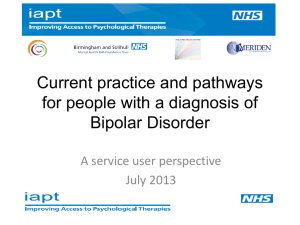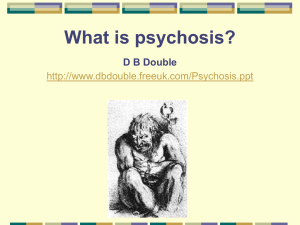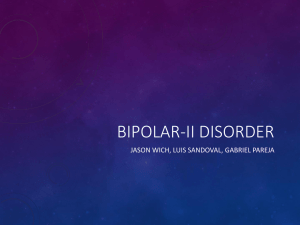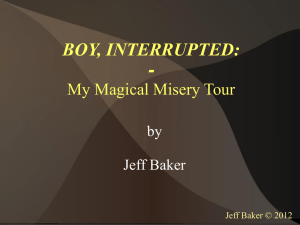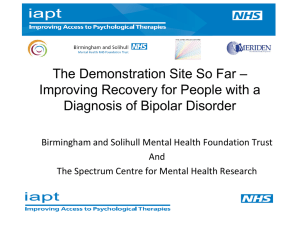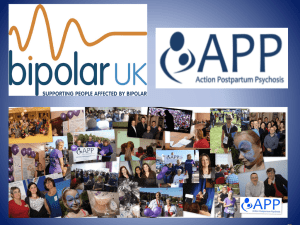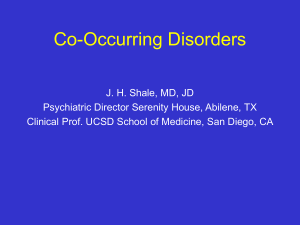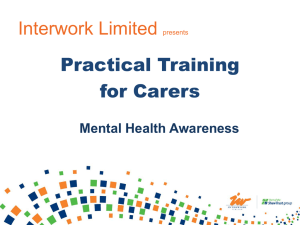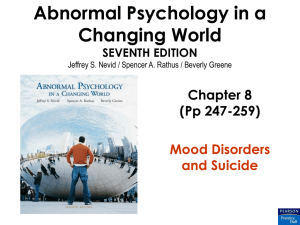PEDIATRIC BIPOLAR DISORDER: A COMPLEX ISSUE
advertisement
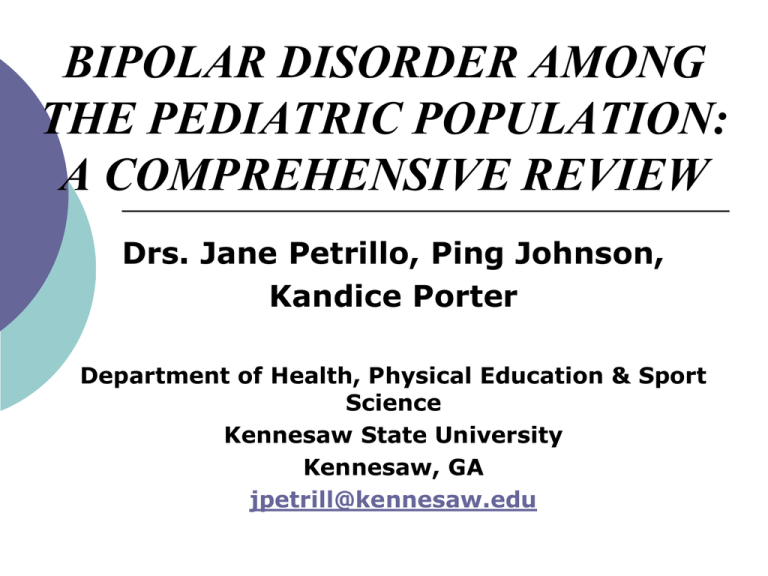
BIPOLAR DISORDER AMONG THE PEDIATRIC POPULATION: A COMPREHENSIVE REVIEW Drs. Jane Petrillo, Ping Johnson, Kandice Porter Department of Health, Physical Education & Sport Science Kennesaw State University Kennesaw, GA jpetrill@kennesaw.edu Presentation Goals: Identify early, accurate diagnostic strategies Recognize the common and complex signs, symptoms behaviors Distinguish among the various types Describe components of a comprehensive treatment plan Examine factors that contribute to effective outcomes and those that hinder treatment effectiveness Bipolar Disorder A mood disorder in which feelings, thoughts, behaviors, and perceptions are altered in the context of episodes of mania and depression. 5.7 million American adults are diagnosed yearly Large proportion of them experience their onset during childhood (up to 20%) - “Early Onset” Bipolar Disorder At least half of all cases start before age 25 An under-recognized and difficult to diagnose, serious mental health problem among children and adolescents If left untreated, may result in: Higher rates of intentional and unintentional injuries Suicide Academic Problems Family, Peer, Social Problems Juvenile Imprisonment Substance Abuse The Diagnostic and Statistical Manual of Mental Disorders, 4th edition, text revision (DSM-IV-TR): The DSM-IV describes four types of bipolar disorder Bipolar I - manic or mixed episodes that last at least seven days – or- manic symptoms that are so severe the person needs immediate hospital care. Usually, individual also has depressive episodes, typically lasting at least two weeks. The symptoms of mania or depression must be a major change from the person's normal behavior. Types of Bipolar Disorder Bipolar II - pattern of depressive episodes shifting back and forth with hypomanic episodes, but no full-blown manic or mixed episodes. Bipolar Disorder NOS (Not Otherwise Specified) – presence of symptoms that do not meet diagnostic criteria for either bipolar I or II. The symptoms may not last long enough, or the person may have too few symptoms, to be diagnosed with bipolar I or II. However, symptoms are clearly out of the person's normal range of behavior. Cyclothymia – a mild form of bipolar disorder. Have episodes of hypomania that shift back and forth with mild depression for at least two years (one year for children and adolescents). However, the symptoms do not meet the diagnostic requirements for any other type of bipolar disorder. Diagnosis: A Major Challenge Bipolar disorder does not affect every child in the same way. The frequency, intensity, and duration of a child’s symptoms and the child’s response to treatment vary dramatically. Initial diagnostic criteria was based on adult symptoms. In adults, bipolar disorder commonly involves separate episodes of major depression, alternating with separate episodes of mania. In children, mixed states of cycling (mood swings) are more common. When children have manic symptoms that last for less than four days, experts recommend that they be diagnosed with BP-NOS (Not Otherwise Specified). Some scientific evidence indicates that approximately one-third of these children will develop longer episodes within a few years. If so, they meet the criteria for bipolar I or II. Diagnosis: A Major Challenge Some experts believe that children with severe irritability, emotional instability, and severe temper outbursts are bipolar. Others believe this view will lead to over diagnosis of children who are actually suffering from disorders other than bipolar disorder – and argue for a narrower definition of bipolar disorder which includes episodic mood swings, elevated or expansive mood - not just irritable mood - and grandiosity or inappropriate euphoria (extreme joyfulness). Diagnosis: A Major Challenge Other factors further complicate the diagnosis of bipolar disorder in children. 1) A history of severe emotional trauma and/or physical trauma (physical, emotional, sexual abuse can lead to mood swings, emotional outbursts, hallucinations, and extremely severe behavioral problems. 2) AD/HD *Improving our understanding and awareness of these “other” factors and related symptoms can lead to a more accurate diagnosis and effective multi-level treatment strategies. AD/HD - Bipolar Disorder A significant overlap exists in the symptoms of mania, and to a lesser extent depression, and the symptoms of AD/HD. AD/HD, mania and depression involve inability to concentrate and problems with distractibility. Mania and AD/HD may both involve hyperactivity and impulsivity. AD/HD - Bipolar Disorder (Mania) AD/HD in children usually does not involve mood symptoms such as depression and euphoria to the extent seen in bipolar disorder. AD/HD symptoms usually first appear early in childhood while the onset of bipolar disorder appears to occur later in childhood or adolescence. AD/HD usually have normal sleep patterns –once a child has settled down in bed and is ready for sleep. In contrast, mania, involves decreased need for sleep with the individual still "raring to go" the next day despite little sleep. Also, family history is critical, as both disorders appear to run in families. AD/HD - Bipolar Disorder (Depression) Children with depression more often appear irritable than sad. Children and adolescents are naturally prone to displays of unstable mood. Determining the cause(s) of the moodiness (hormonal, social/peers, parent/child issues, stress, drug use…) is helpful. Identifying the presence of other symptoms of mania or elevated mood, particularly the presence of euphoria or grandiosity at some point, is important in making this diagnostic distinction. Depression - Bipolar Disorder The risk of depression turning into bipolar disorder is 10 percent or less in adults. The risk increases to 20-40 percent for children and adolescent. Risk factors for the eventual development of bipolar disorder in addition to early onset of depression include: Psychosis; sudden onset, severely slowed or retarded movement; antidepressant-induced mania or elevated mood; and family history of bipolar disorder Diagnosis – Ruling out other Possible Health Problems Other health concerns must first be ruled out to arrive at an accurate diagnosis. A complete physical exam and medical workup should be conducted for a child who is exhibiting significant variability in mood. Physical conditions can manifest symptoms similar to bipolar disorder. “Other” Possible Conditions AIDS Brain Tumor Diabetes Epilepsy Lupus Lyme Disease Multiple Sclerosis Neurosyphilis Sodium Imbalance Thyroid Disorder Diagnosis Need for a specific – accurate diagnostic tool DSM-IV describes symptoms of 4 types Young Mania Rating Scale (YMRS) (http://www.psych.uic.edu/csp/facilities/rating%20scales/YMRS.pdf) Parent Version of the YMRS (http://www.healthyplace.com/images/stories/bipolar/p-ymrs.pdf) Screening Tools-Bipolar Disorder/Mania Symptoms http://www2.massgeneral.org/schoolpsychiatry/screeningtools_table.asp Screening Tool Rating Scale For Ages (Years) Who Completes Checklist: Number of Time to Complete (Minutes) Items Young Mania Rating Scale (YMRS) 5-7 Parent Version of the Young Mania Rating Scale (P-YMRS) Clinician: 11 15-30 Parent, Teacher: 11 5 General Behavior Inventory (GBI) Parent Version, 11+ Student: 73 General Behavior Inventory (P-GBI) 5-17 Parent: Kiddie Schedule for Affective Disorders and Schizophrenia (Kiddie-SADS) 6-18 Clinician 90-120 Weinberg Screening Affective Scale (WSAS) 7-17 Student: 56 5 Mood Disorder Questionnaire (MDQ) 12+ Student: 15 5-10 Diagnosis A diagnosis should never be based on a symptom questionnaire alone. It is important for the individual to have a complete developmental, social, behavioral, educational and family history as well as information about previous interventions and their effectiveness. Very Common Symptoms of Early-Onset Bipolar Disorder: Separation anxiety Rages & explosive temper tantrums (lasting up to several hours) Marked irritability Oppositional behavior Frequent mood swings Distractibility Hyperactivity Very Common Symptoms of EarlyOnset Bipolar Disorder: Impulsivity Restlessness/fidgetiness Silliness, goofiness, giddiness Racing thoughts Aggressive behavior Grandiosity Carbohydrate cravings Very Common Symptoms of Early-Onset Bipolar Disorder: Risk-taking behaviors Depressed mood Lethargy Low self-esteem Difficulty getting up in the morning Social anxiety Oversensitivity to emotional or environmental triggers Common Symptoms of Early-Onset Bipolar Disorder Bed-wetting (especially in boys) Night terrors Rapid or pressured speech Obsessive behavior Excessive daydreaming Compulsive behavior Common Symptoms of Early-Onset Bipolar Disorder Motor & vocal tics Learning disabilities Poor short-term memory Lack of organization Fascination with gore or morbid topics Hypersexuality Common Symptoms of Early-Onset Bipolar Disorder Manipulative behavior Bossiness Lying Suicidal thoughts Destruction of property Paranoia Hallucinations & delusions Less Common Symptoms of Early-Onset Bipolar Disorder Migraine headaches Binging Self-mutilating behaviors Cruelty to animals Treatment A child with bipolar disorder needs medical treatment - but medication alone is only one component of an effective treatment plan Patients must receive comprehensive treatment throughout life to maintain functionality An effective treatment plan for bipolar disorder requires three essential elements: 1) Medication 2) Lifestyle and Environmental Changes and Support 3) School and Academic Accommodations Medications help alleviate and reduce symptoms so they are less intrusive, smooth out mood fluctuations, reduce anxiety and distractibility, and increase frustration tolerance. Because stress is a trigger that intensifies bipolar symptoms and causes a decline in overall level of functioning, lifestyle and school changes should be made to reduce stress. Treatment – Medication and Psychotherapy Mood Stabilizers, Antipsychotics, and Atypical Antipsychotics Agents (Lithium, lithium carbonate, Clozaril, Risperdal, Zyprexa, Seroquel ) Anticonvulsants (Depakote, Tegretol, Trileptal, Lamictal, Topamax, Gabatril) Often, it is necessary to use 3-4 medications to effectively treat a child or adolescent with a bipolar disorder. Regular therapy sessions with a licensed clinical social worker, a licensed psychologist, or a psychiatrist. Cognitive behavioral therapy, interpersonal therapy, and multi-family support groups. A support group for the child or adolescent with the disorder can also be beneficial. Medication – Side Effects Nausea Increased or decreased appetite Excessive thirst Frequent urination Disinhibition Aggression (rare) Diarrhea or constipation Dry mouth Cognitive dulling Hyperactivity Muscle tremors Drowsiness Fidgeting or pacing Restlessness Chills or hot flashes (rare) Vision problems Weight gain Lifestyle/Environmental Changes and Support Family must understand and accept bipolar disorder as a chronic medical condition, participate in psychosocial therapies and create effective individual, family, and community support networks. Counseling services and psychoeducation help the child deal with many effects of the illness and therapy for family members can help the family cope and reduce tensions at home. In addition, research reveals that keeping a consistent sleep schedule, regular exercise, and maintaining a healthy diet is highly critical. Lifestyle/Environmental Changes and Support A child with bipolar disorder needs a supportive and caring, consistent, yet flexible environment providing predictability and emotional stability. Parents should choose recreational and other activities for the child with these criteria in mind. Parents should also ensure that the child is not burdened with more activities than he/she can comfortably handle/manage. Also important to provide for sufficient time in the child's schedule to recover from the stresses that a child with bipolar illness endures during ordinary activities. School and Academic Accommodations In school, a child with bipolar disorder needs a consistent predictable schedule with advance notice of schedule changes and time and assistance to prepare for transitions throughout the school day. Teachers working with the parents to adjust homework requirements as needed to ensure that the child is able to get needed sleep, participate in psycho-educational programs and individual therapies as needed. Children with bipolar disorder often feel overwhelmed by seemingly ordinary events and challenges - Provide designated "safe" adults to whom children can turn and "safe places" where they can seek refuge in times of emotional crisis – Goal is to defuse these crises. School and Academic Accommodations Social skill and Conflict resolution training Anger management Problem-solving skill development Self-esteem development Modify school schedule and provide flexibility in procedural rules: Unlimited bathroom use Access to water as needed Shortened schedule Late start as needed Consistent schedule Provide notice before any transition or change in schedule Permission to move around when needed Naps as needed for primary education students Positive behavioral intervention plan School and Academic Accommodations Modified or shortened class assignments and homework Testing in small groups or one-on-one Extended deadlines for assignments Regular home-school communication via assignment notebook and teacher-parent meetings/communications Additional School/Academic Accommodations Preschool special education testing and services Small class size (with children of similar intelligence) or self-contained classroom with other emotionally fragile (not "behavior disorder") children for part or all of the day One-on-one or shared special education aide to assist child in class Recorded books as alternative to selfreading when concentration is low Art therapy and music therapy Additional School/Academic Accommodations Extended time on tests Use of calculator for math Extra set of books/resources at home Use of keyboard or dictation for writing assignments Regular sessions with a social worker or school psychologist Social skills groups and peer support groups Annual in-service training for teachers by child's treatment professionals (sponsored by school) Enriched art, music, recreation, or other areas of particular strength Curriculum that engages creativity and reduces boredom (for highly creative children) Tutoring during extended absences Goals set each week with rewards for achievement Additional School/Academic Accommodations Summer services such as day camps and special education summer school Placement in a day hospital treatment program for periods of acute illness that can be managed without inpatient hospitalization Placement in a therapeutic day school during extended relapses or to provide a period of extra support after hospitalization and before returning to regular school Placement in a residential treatment center during extended periods of illness if a therapeutic day school near the family's home is not available or is unable to meet the child's needs Resources for parents about bipolar disorders School and Academic Accommodations Student Management Plan = Academic and Behavioral Success Expectations (rules) should be simple, clear, and phrased in positive or neutral language. (Keep hands to self; please raise hand to speak) Issue only one specific direction at a time and modify assignments. (Complete 10 math problems instead of the entire assignment) Tailor/individualize the identified target behaviors Accommodate the child's fluctuating level of stability with a menu of behavioral and academic expectations. Administrative support is critical Reward the child for positive behavior Student Management Plan = Academic and Behavioral Success Continue to expect the best from the child and though the student may have behaved poorly in the past - Must remove lingering bias from prior misbehaviors which will assist the child in demonstrating new social skills. Ignore minor issues as it is impossible to change everything at once. Focus on the big picture and goal-setting. Set realistic expectations. Consistently create opportunities for the child to be successful and share unique talents and strengths to help foster development of positive relationships with self, teachers, and peers. Prevention/Early Detection Early Detection Proactive universal screening Evaluating at-risk students in primary grades for emerging antisocial behavior patterns difficulties with peer and teacher relationships aggressive and disruptive behavior internalizing behaviors: e.g., anxiety, inattention withdrawn behavior in the classroom Diagnosis and Treatment is critical: Prior to condition progresses; or If child is disciplined for an unknown/uncontrollable disorder or condition Prevention/Early Detection Bipolar can be genetic: Parents should be tested for psychological disorders Be aware of signs and symptoms of other conditions – (ADHD, behavioral disorder, anxiety disorders and depression) Behavioral signs in children can be key signs in discovering bipolar disorder Knowing/being aware of the signs See a doctor immediately if any of the signs appear References/Resources Birmaher B, Axelson D, Strober M, Gill MK, Valeri S, Chiappetta L, Ryan N, Leonard H, Hunt J, Iyengar S, Keller M. “Clinical course of children and adolescents with bipolar spectrum disorders.” Archives of General Psychiatry. 2006 Feb;63(2):175-83. Child and Adolescent Bipolar Foundation (CABF) www.bpkids.org Cincinnati Children's Hospital Medical Center, Resource Center on Mental Health Wellness. (2010). http://www.cincinnatichildrens.org Juvenile Bipolar Research Foundation (2010) http://www.jbrf.org/index.html Kowatch, R.A., Fristad, M., Birmaher,B., Wagner, K.D., Findling, R.L., Hellander, M. (2005). “Treatment Guidelines for Children and Adolescents With Bipolar Disorder: Child Psychiatric Workgroup on Bipolar Disorder.” J. AM. ACAD. CHILD ADOLESC. PSYCHIATRY, 44:3, 213. Massachusetts General Hospital, School Psychiatry Program and MADI Resource Center (2010) http://www2.massgeneral.org/schoolpsychiatry/screeningtools_table.asp National Alliance for the Mentally Ill (NAMI) http://www.nami.org/ National Institute of Mental Health (2010). “Bipolar Disorder in Children and Teens.” Science Writing and Dissemination Branch. Bethesda, MD The Depression and Bipolar Support Alliance (DBBSA) http://www.dbsalliance.org/index.html
